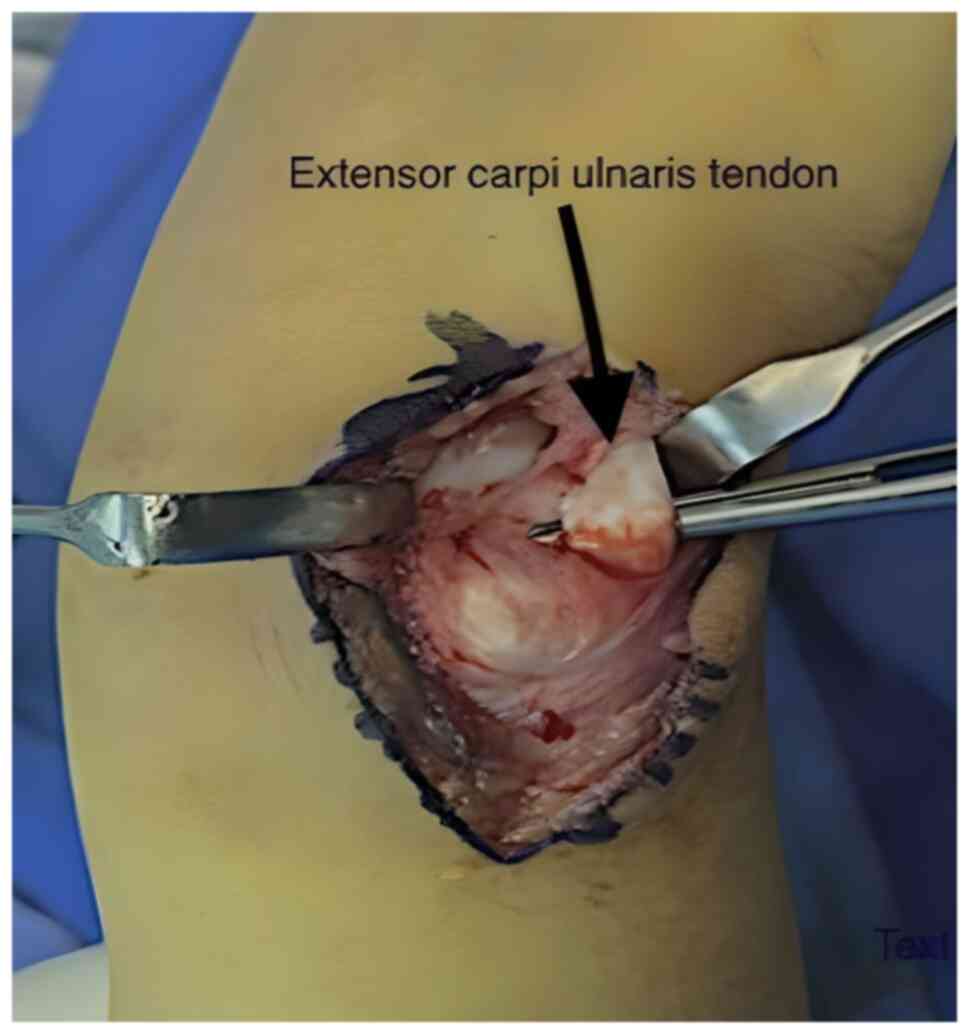|
1
|
Jawed A, Ansari MT and Gupta V: TFCC
injuries: How we treat? J Clin Orthop Trauma. 11:570–579.
2020.PubMed/NCBI View Article : Google Scholar
|
|
2
|
Haugstvedt JR, Langer MF and Berger RA:
Distal radioulnar joint: Functional anatomy, including
pathomechanics. J Hand Surg Eur Vol. 42:338–345. 2017.PubMed/NCBI View Article : Google Scholar
|
|
3
|
Wu WT, Chang KV, Mezian K, Naňka O, Yang
YC, Hsu YC, Hsu PC and Özçakar L: Ulnar Wrist Pain Revisited:
Ultrasound diagnosis and guided injection for triangular
fibrocartilage complex injuries. J Clin Med. 8(1540)2019.PubMed/NCBI View Article : Google Scholar
|
|
4
|
Chan JJ, Teunis T and Ring D: Prevalence
of triangular fibrocartilage complex abnormalities regardless of
symptoms rise with age: Systematic review and pooled analysis. Clin
Orthop Relat Res. 472:3987–3994. 2014.PubMed/NCBI View Article : Google Scholar
|
|
5
|
Spies CK, Müller LP, Oppermann J, Hahn P
and Unglaub F: Instability of the distal radioulnar joint-an
overview of clinical and radiological procedures regarding their
efficacies. Handchir Mikrochir Plast Chir. 46:137–150.
2014.PubMed/NCBI View Article : Google Scholar : (In German).
|
|
6
|
Ng AWH, Griffith JF, Fung CSY, Lee RKL,
Tong CSL, Wong CWY, Tse WL and Ho PC: MR imaging of the traumatic
triangular fibrocartilaginous complex tear. Quant Imaging Med Surg.
7:443–460. 2017.PubMed/NCBI View Article : Google Scholar
|
|
7
|
Atzei A, Luchetti R and Garagnani L:
Classification of ulnar triangular fibrocartilage complex tears. A
treatment algorithm for Palmer type IB tears. J Hand Surg Eur Vol.
42:405–414. 2017.PubMed/NCBI View Article : Google Scholar
|
|
8
|
Zhan H, Bai R, Qian Z, Yang Y, Zhang H and
Yin Y: Traumatic injury of the triangular fibrocartilage complex
(TFCC)-a refinement to the Palmer classification by using
high-resolution 3-T MRI. Skeletal Radiol. 49:1567–1579.
2020.PubMed/NCBI View Article : Google Scholar
|
|
9
|
McNamara CT, Colakoglu S and Iorio ML: A
systematic review and analysis of palmer type I triangular
fibrocartilage complex injuries: Outcomes of treatment. J Hand
Microsurg. 12:116–122. 2020.PubMed/NCBI View Article : Google Scholar
|
|
10
|
Jung HS, Kim SH, Jung CW, Woo SJ, Kim JP
and Lee JS: Arthroscopic transosseous repair of foveal tears of the
triangular fibrocartilage complex: A systematic review of clinical
outcomes. Arthroscopy. 37:1641–1650. 2021.PubMed/NCBI View Article : Google Scholar
|
|
11
|
Hung CY, Chang KV and Özçakar L: Dynamic
and doppler ultrasound imaging for the diagnosis of triangular
fibrocartilage complex injury and ulnocarpal wrist instability. Am
J Phys Med Rehabil. 95:e111–e112. 2016.PubMed/NCBI View Article : Google Scholar
|
|
12
|
Casadei K and Kiel J: Triangular
Fibrocartilage Complex. In: StatPearls (Internet). StatPearls
Publishing, Treasure Island, FL, 2022.
|
|
13
|
Boer BC, Vestering M, van Raak SM, van
Kooten EO, Huis In ‘t Veld R and Vochteloo AJH: MR arthrography is
slightly more accurate than conventional MRI in detecting TFCC
lesions of the wrist. Eur J Orthop Surg Traumatol. 28:1549–1553.
2018.PubMed/NCBI View Article : Google Scholar
|
|
14
|
Cody ME, Nakamura DT, Small KM and
Yoshioka H: MR Imaging of the triangular fibrocartilage complex.
Magn Reson Imaging Clin N Am. 23:393–403. 2015.PubMed/NCBI View Article : Google Scholar
|
|
15
|
Andersson JK, Åhlén M and Andernord D:
Open versus arthroscopic repair of the triangular fibrocartilage
complex: A systematic review. J Exp Orthop. 5(6)2018.PubMed/NCBI View Article : Google Scholar
|
|
16
|
Lee JK, Hwang JY, Lee SY and Kwon BC: What
is the natural history of the triangular fibrocartilage complex
tear without distal radioulnar joint instability? Clin Orthop Relat
Res. 477:442–449. 2019.PubMed/NCBI View Article : Google Scholar
|
|
17
|
Saito T, Sterbenz JM and Chung KC:
Chronologic and geographic trends of triangular fibrocartilage
complex repair. Hand Clin. 33:593–605. 2017.PubMed/NCBI View Article : Google Scholar
|
|
18
|
Liu EH, Suen K, Tham SK and Ek ET:
Surgical repair of triangular fibrocartilage complex tears: A
systematic review. J Wrist Surg. 10:70–83. 2021.PubMed/NCBI View Article : Google Scholar
|
|
19
|
Matsumoto T, Tang P, Fujio K, Strauch RJ
and Rosenwasser MP: The optimal suture placement and bone tunnels
for TFCC repair: A cadaveric study. J Wrist Surg. 7:375–381.
2018.PubMed/NCBI View Article : Google Scholar
|
|
20
|
Kim B, Yoon HK, Nho JH, Park KH, Park SY,
Yoon JH and Song HS: Arthroscopically assisted reconstruction of
triangular fibrocartilage complex foveal avulsion in the ulnar
variance-positive patient. Arthroscopy. 29:1762–1728.
2013.PubMed/NCBI View Article : Google Scholar
|
|
21
|
Anderson ML, Larson AN, Moran SL, Cooney
WP, Amrami KK and Berger RA: Clinical comparison of arthroscopic
versus open repair of triangular fibrocartilage complex tears. J
Hand Surg Am. 33:675–682. 2008.PubMed/NCBI View Article : Google Scholar
|
|
22
|
Lee SH and Gong HS: Grip strength
measurement for outcome assessment in common hand surgeries. Clin
Orthop Surg. 14:1–12. 2022.PubMed/NCBI View Article : Google Scholar
|
|
23
|
Atzei A, Luchetti R and Braidotti F:
Arthroscopic foveal repair of the triangular fibrocartilage
complex. J Wrist Surg. 4:22–30. 2015.PubMed/NCBI View Article : Google Scholar
|
|
24
|
Im J, Kang SJ and Lee SJ: A comparative
study between conservative and surgical treatments of triangular
fibrocartilage complex injury of the wrist with distal radius
fractures. Clin Orthop Surg. 13:105–109. 2021.PubMed/NCBI View Article : Google Scholar
|
|
25
|
Feitz R, van der Oest MJW, van der Heijden
EPA, Slijper HP, Selles RW and Hovius SER: Hand-Wrist Study Group.
Patient-reported outcomes and function after reinsertion of the
triangular fibrocartilage complex by open surgery. Bone Joint J.
103-B:711–717. 2021.PubMed/NCBI View Article : Google Scholar
|
|
26
|
Luchetti R, Atzei A, Cozzolino R, Fairplay
T and Badur N: Comparison between open and arthroscopic-assisted
foveal triangular fibrocartilage complex repair for post-traumatic
distal radio-ulnar joint instability. J Hand Surg Eur Vol.
39:845–855. 2014.PubMed/NCBI View Article : Google Scholar
|
|
27
|
Moritomo H: Open repair of the triangular
fibrocartilage complex from palmar aspect. J Wrist Surg. 4:2–8.
2015.PubMed/NCBI View Article : Google Scholar
|















